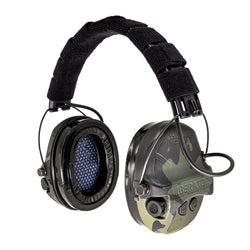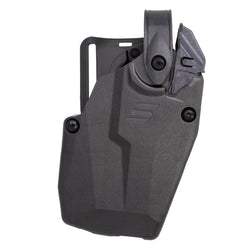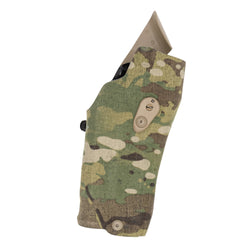The Marine Corps is a unique branch of the United States military. As the famous phrase originally penned in a letter by Commandant Krulak goes,—the nation doesn’t strictly need a Marine Corps, but it wants a Marine Corps. Throughout the its history, the Marine Corps has wielded a number of unique weapons; today, we are going to document those unique weapons.
While the Marine Corps has largely fielded the same small arms as the rest of the military, there have been times when they’ve gotten unique weapons. Sometimes the weapons on this list were shared with the Navy, but I’m counting them since the Marine Corps is the only ground element fielding the guns. I’m also focusing mostly on the modern cartridge era.
Let’s dig into the unique small arms of America’s premier fighting force.
Rifles
The Marine Corps is a Corps of Riflemen, and that ethos runs deep, so it’s only appropriate that we start with rifles.
M1895 Lee-Navy
The Marine Corps adopted the M1895 Lee-Navy in the late 1890s. The goal was to provide Marines with a modern repeating rifle. The rifle chambered the 6mm Lee Navy, which was smaller and lighter than the Army’s cartridge — the smallest caliber adopted until the adoption of 5.56.

Ultimately, a lighter cartridge allowed Marines to carry more ammunition into battle. The Lee-Navy was a straight-pull bolt action rifle, which also differed from the Army’s standard bolt action. The straight-pull design paired with relatively light recoil allowed Marines to shoot both fast and straight.
M1941 Johnson Rifle
A common theme amongst the unique weapons of the USMC is the Army getting the good stuff and the Marines making do. The semi-automatic M1941 Johnson rifle was an M1 Garand competitor, and due to a lack of M1 Garands, elements of the USMC fielded the Johnson rifle.

Notable Marine Raiders and the short-lived ParaMarines fielded the rifle in WW2. The rifle used a short recoil design paired with a 10-round magazine. Unlike the Garand, the Johnson rifle could be topped off with additional ammo with a round chambered.
M40 Sniper Rifle
With Vietnam proving the efficiency of the sniper in asymmetric warfare, the Marine Corps began developing the M40 Sniper rifle. The M40 was a Remington 700 short-action design. This sniper rifle has served for decades, and the precision armorers at Quantico have continually updated the rifle.

The bolt-action precision rifle served from the Vietnam War until the end of the Global War on Terror. It was a purely Marine Corps-led design.
M27 IAR
The Marine Corps initially adopted the M27 IAR as a replacement for the M249 Light Machine Gun. After favorable reviews and usage, the M27 IAR replaced the M16A4 and M4 with Marine Corps combat arms forces. The rifle looks similar to the M16 series, but uses a short-stroke gas piston system.

The M27 IAR’s role is to provide suppression via precision rather than massed fire. The design is a variant of the HK 416, which is in wide use with special operations forces. Several variants of the M27 exist, including the M38 designated marksman’s rifle, and the Recon Weapons Kit carbine variant with a much shorter barrel.
Machine Guns
As a former machine gunner, I have a penchant for anything full auto and the Marine Corps does not disappoint.
Colt M1895
The John Browning creation known as the M1895 Machine gun was also affectionately called the potato digger due to the swinging lever-action apparatus. The M1895 was essentially a gas-operated, full-auto lever-action design. With the Marine Corps, it fired the 6mm Lee-Navy cartridge.

In the 1898 Invasion of Guantanamo Bay, Cuba, the Marine Corps fielded the M1895 in the first recorded use of machine guns to provide tactical support to infantry forces on the assault. This doctrine later became the basis of small unit maneuver combat.
M2 Stinger
Marines in WW2 fielded the Browning M1919, and while the rifle performed, they wanted a more infantry-friendly version with a higher rate of fire. Showing tenacity and the ability to improvise, Marines took AN/M2 1919 models from downed aircraft and converted them into infantry machine guns. They added M1 Garand stocks and BAR bipods to the belt-fed beast.

The Stingers put out 1,200 rounds per minute and were incredibly effective. Corporal Tony Stein earned the Medal of Honor by unleashing the Stinger on Japanese forces on Iwo Jima. Only six M2 Stingers were ever produced.
M1941 Johnson Light Machine Gun
Much like the M1 Garand, there weren’t enough BARs to go around. The Marine Corps needed a light machine gun and the M1941 Johnson Light Machine Gun proved sufficient. The Johnson LMG was a short-recoil operated .30-06 that fired from a side-mounted magazine.

The machine gun was lighter and shorter than the BAR and had the unique ability to fire from a closed bolt in semi-auto and an open bolt in full auto. This improved reliability in semi-auto and prevented cookoffs in full auto. ParaMarines and Marine Raiders most commonly fielded the Johnson.
Stoner 63
The Stoner 63 was a modular system that could be converted from rifle to carbine to light machine gun. Eugene Stoner designed the rifle, and both the Marine Corps and SEALs experimented with the design. Marine infantry battalions fielded the rifle variant, the auto rifle variant, and the light machine gun variant.

While feedback was positive, the Marine Corps did not adopt the Stoner 63 in any great numbers. Force Recon elements employed the light machine gun variant extensively, but after Vietnam, the Marine Corps ditched the weapon.
Submachine Guns
Submachine guns have an interesting history with the Marine Corps. They were the first to adopt the Thompson and found that it greatly increased their squad’s firepower. Outside of the Thompson, they had several unique submachine guns.
M50 Reising
Even though the Marine Corps first fielded the Thompson, there wasn’t enough for both the Army and the Marine Corps in WW2. The Marine Corps adopted the M50 Reising as a stopgap measure. The M50 was a .45 ACP submachine gun, and they also adopted the M55 with a folding stock for Paratroopers.

The M50 Reising design used a delayed blowback design and fired from the closed bolt, which made it somewhat rare for the time. The M50 Reising was notoriously finicky and not reliable enough for military use.
Beretta Model 12
The Marine Corps never officially fielded the Beretta M12, but Marines are tasked with guarding embassies, and in the Vietnam Era, they utilized weaponry issued by the State Department. This included the Beretta Model 12.

The M12 was a 9mm, open bolt submachine gun known for its reliability. Marine Embassy Guards fought off a hellacious attack from Vietnamese forces during the Tet Offensive. They held off numerically superior forces armed with AKs and RPGs until they could be reinforced.
Colt SMG
Fast forward a few decades, and Marines tasked with protecting embassies were armed with Colt SMGs. The Colt SMG was a 9mm, closed-bolt, blowback-operated gun that mimicked the M16 in terms of controls and layout. This made it an easy transition for Marines trained with the M16.

The Colt SMG was a reliable weapon, and before the era of short carbines, it provided a lightweight, short weapon well-suited for embassy security duty.
Handguns
Handguns are not all that critical in warfighting, but the Marine Corps has fielded a few unique handguns worth mentioning.
Colt M1905 Marine Corps
The military adopted the Colt M1892 for a short period of time, but the Marine Corps placed a special order for a variant of the M1892 known as the M1905. This .38 Long Colt revolver featured a rounded grip frame and a special set of checkered grips. Other than that, it was a Colt M1892.

This was the first pistol exclusively ordered for the United States Marine Corps. Only 1,000 were ordered, and it’s one of the rarest military surplus pistols on the market.
Colt Python
Again, the Marine Corps never issued the Python to Marines, but Marines assigned to embassy duty might have found themselves carrying a Python. Most Marines carried the S&W Model 10 on embassy duty, but Marines assigned to personal security details for important embassy staff fielded the Colt Python.

The Python was a modern .357 Magnum revolver. It was big, heavy, and stout. The Python was likely issued to fewer than a dozen Marines, but it counts for our purposes.
MEU/SOC M1911s
The entire military carried the M1911, but the Marine Corps kept it around long after the adoption of the M9 with the Force Recon community. The MEU/SOC variants are unique to the United States Marine Corps and have evolved extensively and been customized by the Marine Corps Precision Weapons Section.

This line concluded with the Colt M45A1, a railed M1911 with an FDE Cerakote finish. This would be the last M1911 to serve with the Marine Corps after the adoption of the M18 series.
The Few, The Proud, The Marines
The Marine Corps’ unique nature has sometimes resulted in unique weapons, and other times it’s due to the Marine Corps’ red-headed stepchild treatment. Marines make do, and their evolution has continued to prove that America doesn’t need a Marine Corps; America wants a Marine Corps.









